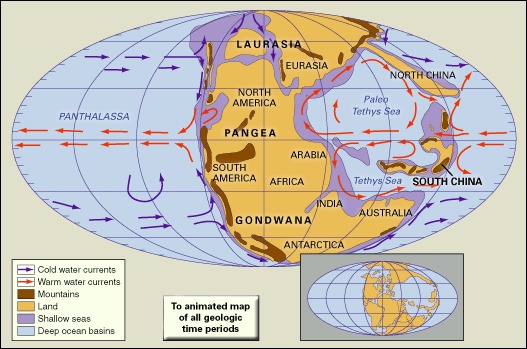Pangea
supercontinent
also spelled Pangaea
in early geologic time, a “supercontinent” that incorporated almost all of Earth's landmasses and covered nearly one-third of Earth's surface. It was surrounded by a global ocean called Panthalassa. Pangea was fully assembled by the Early Permian (Permian Period) Period, some 270 million years ago. It began to break apart about 200 million years ago, during the Early Jurassic (Jurassic Period) Period, eventually forming the modern continents and the Atlantic and Indian Oceans. The existence of the Pangean supercontinent was first proposed in 1912 by the German meteorologist Alfred Wegener (Wegener, Alfred Lothar) as a part of his theory of continental drift. Pangea's name is derived from the Greek pangaia, meaning “all the Earth.”
During the Early Permian, the northwestern coastline of the ancient continent Gondwana collided with and joined the southern Euramerican continent. With the fusion of the Angaran part of Siberia to this combined landmass during the middle of the Early Permian, the assembly of Pangea was complete. Cathaysia, a landmass comprising both North and South China, was not incorporated into Pangea. Rather, it formed a separate, much smaller, continent within the global ocean, Panthalassa.
 The breakup of Pangea is now explained in terms of plate tectonics rather than Wegener's outmoded concept of continental drift. Plate tectonics states that Earth's outer shell, or lithosphere (Earth), consists of large, rigid plates that move apart at oceanic ridges (ocean), come together at subduction zones (ocean), or slip past one another along fault lines (fault). The pattern of seafloor spreading (seafloor spreading hypothesis) indicates that Pangea did not break apart all at once but rather fragmented in distinct stages.
The breakup of Pangea is now explained in terms of plate tectonics rather than Wegener's outmoded concept of continental drift. Plate tectonics states that Earth's outer shell, or lithosphere (Earth), consists of large, rigid plates that move apart at oceanic ridges (ocean), come together at subduction zones (ocean), or slip past one another along fault lines (fault). The pattern of seafloor spreading (seafloor spreading hypothesis) indicates that Pangea did not break apart all at once but rather fragmented in distinct stages. The first oceans formed from the breakup, some 180 million years ago, were the central Atlantic Ocean between northwestern Africa and North America and the southwestern Indian Ocean between Africa and Antarctica. The South Atlantic Ocean opened about 140 million years ago as Africa separated from South America. About the same time, India separated from Antarctica and Australia, forming the central Indian Ocean. Finally, about 80 million years ago, North America separated from Europe, Australia began to rift away from Antarctica, and India broke away from Madagascar. India eventually collided with Eurasia approximately 50 million years ago, forming the Himalayan mountains (Himalayas).
The first oceans formed from the breakup, some 180 million years ago, were the central Atlantic Ocean between northwestern Africa and North America and the southwestern Indian Ocean between Africa and Antarctica. The South Atlantic Ocean opened about 140 million years ago as Africa separated from South America. About the same time, India separated from Antarctica and Australia, forming the central Indian Ocean. Finally, about 80 million years ago, North America separated from Europe, Australia began to rift away from Antarctica, and India broke away from Madagascar. India eventually collided with Eurasia approximately 50 million years ago, forming the Himalayan mountains (Himalayas).During Earth's long history, there probably have been several Pangea-like supercontinents. The oldest of these supercontinents is called Rodinia and was formed during Precambrian (Precambrian time) time some 1 billion years ago. Another Pangea-like supercontinent, Pannotia, was assembled 600 million years ago, at the end of the Precambrian. Present-day plate motions are bringing the continents together once again. Africa has begun to collide with southern Europe, and the Australian plate is now colliding with Southeast Asia. Within the next 50 million years, Africa and Australia will merge with Eurasia to form a supercontinent that approaches Pangean proportions. This episodic assembly of the world's landmasses has been called the supercontinent cycle or Wegenerian cycle, in honour of Alfred Wegener.
- Willimantic
- Willingboro
- Willis, Bruce
- Willis Eugene, Jr. Lamb
- Willis Eugene Lamb, Jr.
- Willis Haviland Carrier
- Willis, Henry
- Willis Reed
- Willis Rodney Whitney
- Willis, Thomas
- Williston
- Willis Van Devanter
- Willkie, Wendell L.
- Willmar
- Willoughby, Francis Willoughby, 5th Baron
- willow
- willow oak
- Willow Palisade
- Willow pattern
- Will Rogers
- Wills, Bob
- Wills, Helen
- Wills, Maury
- Will Smith
- Willstätter, Richard